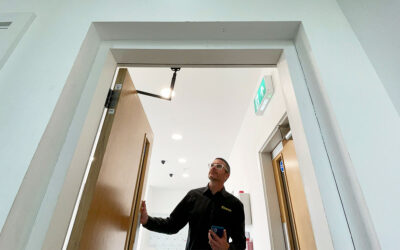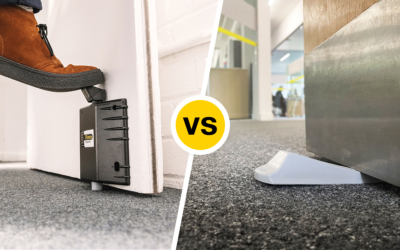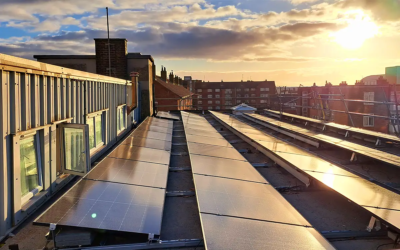A recent fire at a Tottenham warehouse was so severe it required 140 firefighters to tackle the blaze. Though the cause of fire is not yet known, it brings to the forefront the particular issues around fire safety in warehouses. What are the particular challenges in keeping industrial workplaces and warehouses safe?
Combustible materials and dust
Warehouses are often used for storage of dangerous or flammable materials. A segregation policy is vital here; any possible sources of fire need to be completely separated from areas of chemical storage. Fire sources are numerous and can include rubbish, dust, cigarettes or hot work. These need to be removed from the warehouse completely, or segregated from dangerous chemicals completely, using fire safe building materials.
Combustible dust is also a hazard in warehouses and manufacturing plants. If there is a large amount of dust in the area when a fire starts, the dust can become airborne and cause a dangerous secondary explosion. It’s important to ensure a regular housekeeping regime to make sure dust is kept to a minimum.
Hot work
It is not surprising that hot work, such as welding and soldering, is one of the leading causes of industrial fires. Training of staff is vital to ensure they undertake hot work in a safe manner, and of course use common sense when it comes to where the hot work takes place. Keep it away from anything flammable. Make sure staff are supervised if required and have all the correct safety equipment and clothing.
Equipment and machinery
Faulty equipment is a real fire risk, whether it’s an improperly maintained boiler, or poorly serviced machinery. Manufacturers’ instructions regarding servicing and maintenance of equipment must be followed to keep everyone safe.
Electrical fires can also be a problem in industrial environments. Make sure everything is unplugged when not in use (where possible). Don’t overload electrical circuits, and avoid extension leads where you can. Regularly check equipment to make sure it is working properly and wires are safe.
Smoking
It goes without saying that smoking is a fire hazard. In the UK, smoking is illegal in enclosed or substantially enclosed workplaces. However in a warehouse situation, where people may be smoking outside, it is vital that they do this away from stored materials, particularly those that are combustible. Staff need to be very careful about discarding cigarette butts, ensuring they are extinguished completely and put in a safe place.
Compartmentation
In a warehouse setting with so many potential causes of fire, building compartmentation is vital. Areas need to sectioned off, particularly those with combustible materials and dangerous chemicals. Walls and doors need to be fire resistant and fire doors need to be closed to prevent the spread of fire if the worst happens
Approved document B sets out how to safely separate compartments in all types of workplace, and what fire resistant materials are needed to ensure regulations are met.
Click here for more information about building compartmentation.
Risk assessments
As with any place of work, it is vital that the responsible person (i.e. the person in charge of fire safety) carries out a risk assessment, and makes regular checks to ensure this information is up to date.
It is essential that all employers provide comprehensive fire safety training to employees, and make sure any visitors are supervised, and aware of emergency procedures.
Simple steps to take are to make sure the building is regularly cleaned and free of dust and that all exits are kept clear for people to evacuate safely in an emergency. Inspect and maintain all equipment. Place combustible materials away from anything that is an ignition risk, and ensure they are stored safely and according to government guidelines. Make it easy for employees to report anything that they spot as a potential risk.
Fire safety starts with education and training but common sense is crucial. If something looks dangerous, make sure the responsible person is aware so that the problem can be investigated and made safe. Fire prevention is always the safest option.
You might also like
Why it’s time to digitalise your fire door inspections
With the amount of information and recommendations that a detailed inspection report generates, going digital with your fire door inspections will help you stay compliant and in control of all fire doors within your premises.
3 ways to keep your fire doors open (that aren’t a door wedge!)
It’s common knowledge in fire safety circles that wedging doors open is wrong. So you might ask, “Why is this blog about ways to keep fire doors open?” Well, this is about options to do so safely and legally. But first, let’s look at why it’s hazardous to keep fire...
A place in the sun: installing our solar panels
Putting the ‘eco’ into Fireco! As a business, we’re always looking for ways to reduce our impact on the environment, so it made sense to have solar panels installed on the roof of our building. Fireco’s Field Application Engineer, Chris Mitchell, takes us through the project and outlines its benefits.





Hello, I work in an office attached to a warehouse and we are looking to change the fire door in the office to a standard door as its the only way into the office from outside(however it can only be opened from inside). I just wanted to ask if this is legally acceptable, or if it will need to be replaced with another fire door?
Hello Brad. I would advise that you call up and speak to our dedicated fire door team. They will need to ask a few more questions before we can provide the correct answer. Please reach out on 01273 320650 and ask for a member of the fire door team, they will be more than happy to help.